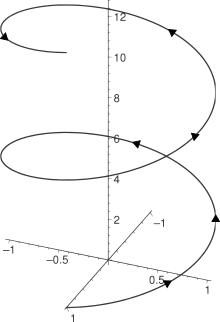Helix
A helix (/ˈhiːlɪks/) is a shape like a corkscrew or spiral staircase. It is a type of smooth space curve with tangent lines at a constant angle to a fixed axis. Helices are important in biology, as the DNA molecule is formed as two intertwined helices, and many proteins have helical substructures, known as alpha helices. The word helix comes from the Greek word ἕλιξ, "twisted, curved".[1]A "filled-in" helix – for example, a "spiral" (helical) ramp – is a surface called helicoid.[2]
The pitch of a helix is the height of one complete helix turn, measured parallel to the axis of the helix.
A double helix consists of two (typically congruent) helices with the same axis, differing by a translation along the axis.[3]
A conic helix, also known as a conic spiral, may be defined as a spiral on a conic surface, with the distance to the apex an exponential function of the angle indicating direction from the axis.
A curve is called a general helix or cylindrical helix[4] if its tangent makes a constant angle with a fixed line in space. A curve is a general helix if and only if the ratio of curvature to torsion is constant.[5]
A curve is called a slant helix if its principal normal makes a constant angle with a fixed line in space.[6] It can be constructed by applying a transformation to the moving frame of a general helix.[7]


